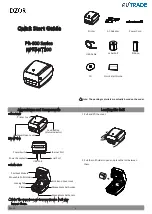
141
WHEN TO ADJUST RECIPES
PROBLEM
PROBABLE CAUSE
SOLUTION
(DESCRIPTION BELOW)
The bread rises too fast.
- Too much yeast, too much flour, not enough salt.
a/b
The bread does not rise at all
or not enough.
- No or too little yeast.
a/b
- Old or stale yeast.
e
- Liquid too hot.
c
- Wrong flour type or stale flour.
d/e
- Too much or not enough liquid.
a/b/g
- Not enough sugar.
a/b
The dough rises too much
and spills over the baking tin.
- If the water is too soft the yeast ferments more.
f
- Too much milk affects the fermentation of the yeast.
c
The bread goes down in the
middle.
- The dough volume is larger than the tin and the bread goes down.
a/f
- The fermentation is too short or too fast due to the excessive temperature of the
water or the baking chamber or due to the excessive moistness.
c/h/i
- No salt or not enough sugar.
a/b
- Too much liquid.
h
Heavy, lumpy structure of
bread.
- Too much flour or not enough liquid.
a/b/g
- Not enough yeast or sugar.
a/b
- Too much fruit, whole meal flour or another ingredient.
b
- Old or stale flour.
e
The bread is not baked in
the center.
- Too much or not enough liquid.
a/b/g
- Too much humidity.
h
- Recipes with moist ingredients, e.g. yogurt.
g
Coarse structure or too many
holes in bread.
- Too much water.
g
- No salt.
b
- Great humidity, too hot water.
h/i
- Too much liquid.
c
Mushroom-like, unbaked
surface.
- Bread volume too big for the tin.
a/f
- Too much flour, especially for white bread.
f
- Too much yeast or not enough salt.
a/b
- Too much sugar.
a/b
- Other sweet ingredients apart from sugar.
b
The slices are uneven or
there lumps in the middle.
- The bread did not cool enough (the vapor has not escaped).
j
Flour deposits on the bread
crust.
- The flour was not worked well on the sides during kneading.
g/i
7. BREAD DOUGH
8. DOUGH
9. JAM
1000 g
1000 g
Large orange
Lemon
Sugar
3 pcs
1/2 piece
260 g
Water
Sugar
Oil
Salt
Milk powder
Flour
Dried yeast
410 ml
1 tbsp
2 tbsp
2 tsp
2 tbsp
630 g
1 tsp
Water
Oil
Salt
Flour
380 ml
2 tbsp
2 tsp
630 g
The tables include examples of recipes and approximate amounts of ingredients. These information should not be treated as a cookery book.
While baking we encourage everyone to use their own recipes or these found in specialist literature, and stick to one’s likings.
ZBM1400-001_v01
Summary of Contents for bm1400
Page 57: ...63 Zelmer 8 8 8 ZBM1400 001_v01 RU...
Page 58: ...64 10 I ZBM1400 001_v01...
Page 64: ...70 10 30 30 START STOP 1 30 1 2 3 4 ZBM1400 001_v01...
Page 68: ...74 1 4 1 2 3 50 300 4 1500 1000 5 BASIC WHOLE WHEAT 500 2 10 1 750 Mo ZBM1400 001_v01...
Page 69: ...75 SWEET 6 PE ZBM1400 001_v01...
Page 70: ...76 Zelmer 8 8 8 ZBM1400 001_v01 BG...
Page 71: ...77 10 LVD 2006 95 EC EMC 2004 108 EC CE ZBM1400 001_v01...
Page 77: ...83 10 30 30 START STOP 1 30 1 2 3 4 ZBM1400 001_v01...
Page 80: ...86 g 1 2 h i 15 j 1 20 40 60 1 5 15 1 1 100 1 80 1 BASIC WHOLE WHEAT 500 2 ZBM1400 001_v01...
Page 81: ...87 750 3 50 300 4 1500 1000 5 SWEET 6 ZBM1400 001_v01...
Page 82: ...88 Zelmer 8 8 8 ZBM1400 001_v01 UA...
Page 83: ...89 10 I LVD 2006 95 EC EMC 2004 108 E CE ZBM1400 001_v01...
Page 89: ...95 10 i 30 i i 30 START STOP 1 30 1 2 3 4 i ZBM1400 001_v01...
Page 93: ...99 26663 19848 5 40 1 15150 50 300 4 1500 1000 5 i SWEET 6 i ZBM1400 001_v01...


































